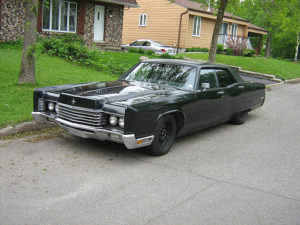Commonly Encountered Torque Converter Problems (Automatic Transmission)
by: Chris Lontok

By denizen24 (Gangster-styled car: 1970 Lincoln Continental) [CC BY 2.0 (http://creativecommons.org/licenses/by/2.0)], via Wikimedia Commons
The pump is attached to directly to the engine, and spins at the same speed as the motor. Inside the pump are many fins, which, as the pump spins, direct hydraulic fluid outward to the turbine. The turbine then spins at close to the same speed as the engine, but in the opposite direction. The spinning of the turbine causes the transmission torque converter to rotate and drive the wheels. The hydraulic fluid exits the turbine at its center, moving in the direction opposite to how it was forced in by the pump.
The beneficial part of a torque converter is that it is able to enhance torque when there is a difference between the input and output speed of rotation, which then provides about the same torque as a reduction gear. A converter can be, and is often, used not only in automobiles but also in boats and in buses used for public transportation.
A converter, like any vehicle part, gets worn out and requires the occasional torque repair or torque converter part replacement. You can also opt to upgrade your converter for a high performance driving experience. When you know the limits of your converter, you can spare yourself from torque repair woes, which is more common than you might think. Of course, most of the problems can be avoided by simply knowing the limitations and capabilities of your converter.
Overheating is probably the most common converter problem encountered by users. There is more than one reason for overheating your converter. There could be a defect on the spark plugs; the distributor timing might be off, or there is continuous high level of slippage. Torque repair shops would have to control this situation by checking for the seals, to make sure they haven’t melted away. Broken seals lead to leaks, and leaks lead to poor circulation of transmission fluid.
Due to sudden loading or excessive heating of the converter, the pump and/or turbine blades may get deformed, separated from their hubs or annular rings. On worse cases, they may even break into fragments. At the least, this type of transmission torque converter will result in a significant loss of efficiency, producing symptoms similar to those seen in stator clutch failure. In extreme cases, you might have to undergo total torque rebuild mode. Replacement of torque converter parts like the turbine and the stator is an expensive process. This problem can be rooted to plain bad and careless driving.
A converter problem called ballooning is also commonly seen among units. What happens is, pressure and stress put on the converter’s housing causes it to distort and eventually break. Hot oil and converter parts will automatically spew out. This is a very serious problem that is caused by prolonged operation under excessive loading, very abrupt application of load, or operating a torque converter at very high RPM. For efficient and high performance of your converters, make it a habit to regulate speed and load. The occasional check up is also helpful.
For torque converter services such as torque repair, torque converter installation, torque converter clutch adjustments, and purchase of new or remanufactured torques, check out Ameritorque. They service the areas of Tampa, Brandon, St Petersburg, Clearwater, Lakeland, Hillsborough, Pinellas, Pasco, and Polk.
| About The Author
Tampa Converter
3023 W Hillsborough Ave Tampa, FL 33614 Phone: (813) 876-3795 Fax: (813) 353-3851 Email: [email protected] Website: http://www.torqueconvertertampa.com The author invites you to visit:
http://www.torqueconvertertampa.com |
Article Source:
http://www.articlecity.com/articles/auto_and_trucks/article_3912.shtml
